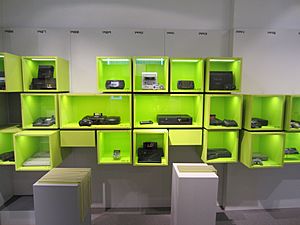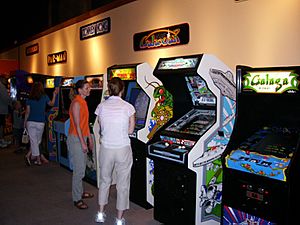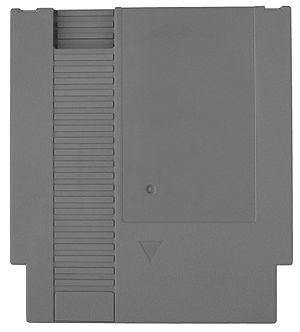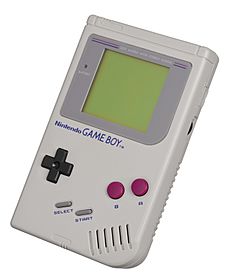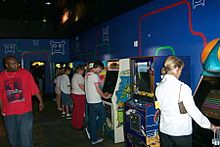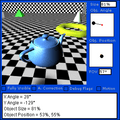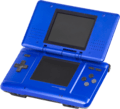Video game facts for kids

Video games are fun electronic games you play on a screen. This screen can be a television, a small screen built into a handheld device, or a computer monitor.
There are many kinds, or genres, of video games. Some popular types include role-playing games, shooters, and platformers.
Video games usually come on CDs, DVDs, or as digital downloads. In the past, many games came on cartridges. A special device used to play video games at home is called a console.
Many different consoles and home computers have been used to play games. Early consoles from the 1980s included the Atari 2600, Sega Master System, and Nintendo Entertainment System. Newer consoles today are the Xbox Series X/S, PlayStation 5, and Nintendo Switch. The PlayStation 2 by Sony is the best-selling video game console ever.
People also play games on PCs, which are called PC games. Older consoles don't get new games often. However, you can play many old console games on new computers using special programs called emulators. This makes old games easy to find and play.
You can play portable video games almost anywhere. Mobile devices like smartphones and tablets (which use operating systems like iOS or Android) can download many games. This turns them into portable gaming machines.
When video game players compete against each other, it's called electronic sports, or esports.
Contents
How Did Video Games Start?
The first video game is often said to be a computer game called Spacewar!. But some ideas for video games existed even before Spacewar! was made.
In the 1950s, when the first computers were being built, a few people had ideas that led to video games. In 1951, Ralph Baer, an engineer, thought about adding a game module to televisions. His idea wasn't used then, but he later created the first video game console, the Odyssey.
Later, in 1952, A.S. Douglas from Cambridge University in the UK made a game called OXO. It was a tic-tac-toe game played on a computer. In 1953, Willy Higinbotham created Tennis For Two, which was similar to the later game Pong. He made it to entertain visitors at a lab.
One of the most famous early video games is Space Invaders. It was made in 1978 as a coin-operated arcade game. Versions of Space Invaders have been made for almost every game console and home computer since then.
What Makes Up a Video Game?

To be a video game, it usually needs a "platform." This is the hardware that processes what you do with a controller and shows the results on a screen.
Gaming Platforms Explained
Video games need a platform to run. A platform is a specific mix of electronic components and software. Games are usually made for one or a few platforms. Sometimes, a game made for one platform is changed to work on another. This is called a "port."
Here are some common types of gaming platforms:
Computer Games
Most computer games are PC games. You play them on a personal computer (PC) connected to a video monitor. PCs are not just for games, so games might run differently on different computers. PCs allow game makers to be creative and offer features like mods (player-made changes) and online gaming. A gaming computer is a PC made especially for playing games, with powerful parts.
Home Consoles
A console game is played on a home console. This is a special electronic device that connects to a television set. Consoles are made just for games. This makes it easier for developers to create games for them. Consoles usually only play games made for them or by the same company. Major console brands include Xbox, PlayStation, and Nintendo.
Handheld Consoles
A handheld gaming device is small and portable. You can hold it in your hands. It has the console, a small screen, speakers, and buttons all in one unit. Handhelds are also dedicated game platforms. They are usually less powerful than PCs or home consoles. Older handhelds from the 1970s and 80s sometimes only played one game. Later ones used cartridges to play many different games. Mobile phones have largely replaced handheld consoles since the 2010s.
Arcade Video Games
An arcade video game is played on a very special machine. It's usually designed for just one game and is in a large, coin-operated cabinet. This cabinet has a screen, controllers (like joysticks and buttons), and speakers. Arcade games often have bright art related to the game's theme. Most arcade games are tall, so you stand to play. Some are tabletop style, where you sit. In the 1980s, video arcades were popular places to play many arcade games. Today, there are fewer arcades, but some movie theaters still have them.
Browser Games
A browser game uses web browser technology. This means you can play them on many different devices. These games might be known by the website they are on, like Miniclip games. Others are named after the programming language used to make them, like Java or Flash games.
Mobile Games
With smartphones and tablet computers becoming popular, mobile gaming is a huge platform. These games can use special features of mobile devices. This includes accelerometers (for tilting the device), GPS (for location), and cameras (for augmented reality games).
Cloud Gaming
Cloud gaming lets you play games with very little hardware. You just need a basic computer, console, phone, or special device connected to a screen. You also need a good internet connection. The game runs on powerful computers far away (in the "cloud"). Your device just shows you the game and sends your commands. This helps reduce lag. Examples include Xbox Cloud Gaming and PlayStation Now.
Virtual Reality (VR) Games
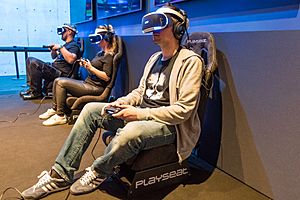
Virtual reality (VR) games need special headsets. These headsets show you a 3D world and track your head movements. This makes you feel like you are inside the game. Some VR systems also have controllers for your hands. This lets you interact directly with the virtual world. VR systems usually need a separate computer or console to power the headset.
Emulation and Older Games
An emulator is a program that lets you play games from older consoles or systems on a newer computer. It pretends to be the old hardware. This lets you play classic games. While emulators are generally legal, getting the game software (ROMs) for games you don't own might be against copyright rules. However, some game companies offer official ways to play old games, like Nintendo's Virtual Console.
Backward Compatibility
Backward compatibility is similar to emulation. It means newer consoles can play older games. This is usually built into the console's hardware or software. For example, the PlayStation 2 could play original PlayStation games just by putting the old disc in. The Wii could also play Nintendo GameCube games.
How Games Are Stored
Early arcade games and consoles had the game built right into their parts. But now, most video game platforms can read and play many different games. These games come on various types of media.
Physical game formats include ROM cartridges, floppy discs, and optical discs like CD-ROMs and DVDs. Many games also come on flash memory cards.
Today, many games are bought through digital distribution over the internet. This means you download the game and don't need a physical disc or cartridge. Sometimes, you install the game from a disc onto your console's storage. This makes games load faster and allows for updates.
Games can also get new content through expansion packs or downloadable content (DLC). These can be free or cost money. Some games let players create their own content to share, called user-generated content. Other games, especially on PCs, allow mods. These are changes or additions made by players.
How You Control Games
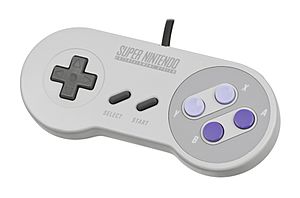
Video games use different input devices to turn your actions into game commands. The most common are gamepads and joysticks for consoles. PCs often use keyboards and mice. Modern controllers have buttons, triggers, analog sticks, and directional pads. Handheld consoles and arcade machines have similar controls built-in.
Newer technology adds features like touchscreens and motion detection sensors. These give you more ways to play. Some games use special controllers like racing wheels, light guns, or dance pads. Cameras and motion sensors can even capture your body movements to control the game.
What You See and Hear
All video games show graphics on a screen. This can be a CRT television, a newer liquid-crystal display (LCD) TV, a projector, or a computer monitor. The quality of the graphics depends on the game platform and the screen. Games can have simple displays, text-based games, two-dimensional or three-dimensional graphics, and even augmented reality.
Games also have sound. This comes from speakers built into the game device or external speakers. You'll hear sound effects for your actions and background music. Some platforms also give you feedback through vibrations. For example, a controller might shake to make you feel an earthquake in the game.
Related Pages
Images for kids
-
Tennis for Two, an early game that used an oscilloscope for a screen.
-
Nolan Bushnell at the Game Developers Conference in 2011.
-
After Pong, the Atari 2600 was the first game console to become very popular.
-
An Xbox 360 console and controller.
-
Project64, a Nintendo emulator, running Star Fox 64 on Windows 8.
-
The gamescom fair in Cologne.
-
The Atari VCS was a popular home video game console in the late 1970s and early 1980s.
-
Spacewar! is known as the first widely available and important computer game.
-
The Magnavox Odyssey, the first home console.
-
Pong was the first arcade game to become widely successful.
-
The Magnavox Odyssey 300, a 1975 Odyssey model.
-
Space Invaders was a popular game during the golden age of arcades.
-
Intellivision was a home console system from 1979.
-
The Nintendo Entertainment System or NES.
-
A model of the TurboGrafx-16.
-
The Sony PlayStation.
-
The Xbox, Microsoft's first video game console.
-
An original model Wii and Wii Remote. It was a global success and started a trend of motion-controlled games.
See also
 In Spanish: Videojuego para niños
In Spanish: Videojuego para niños



